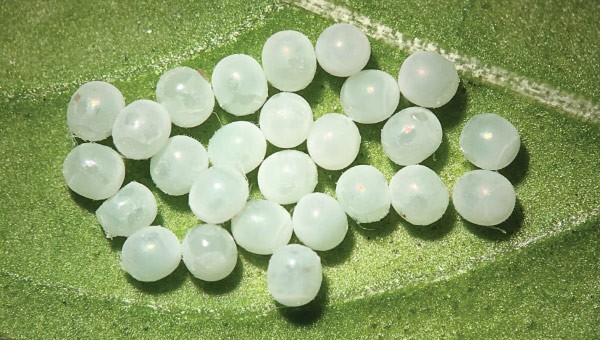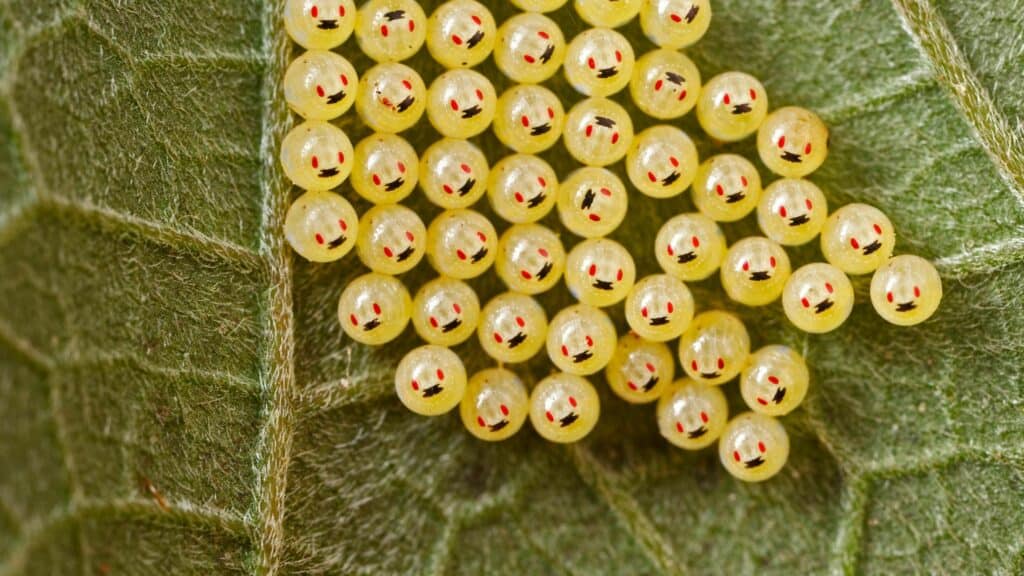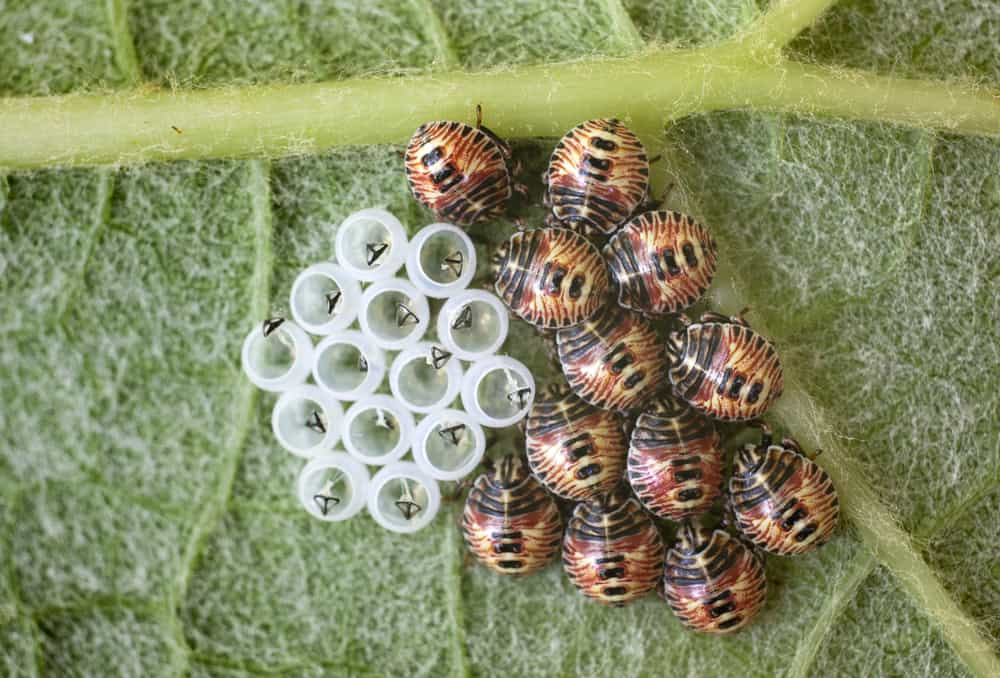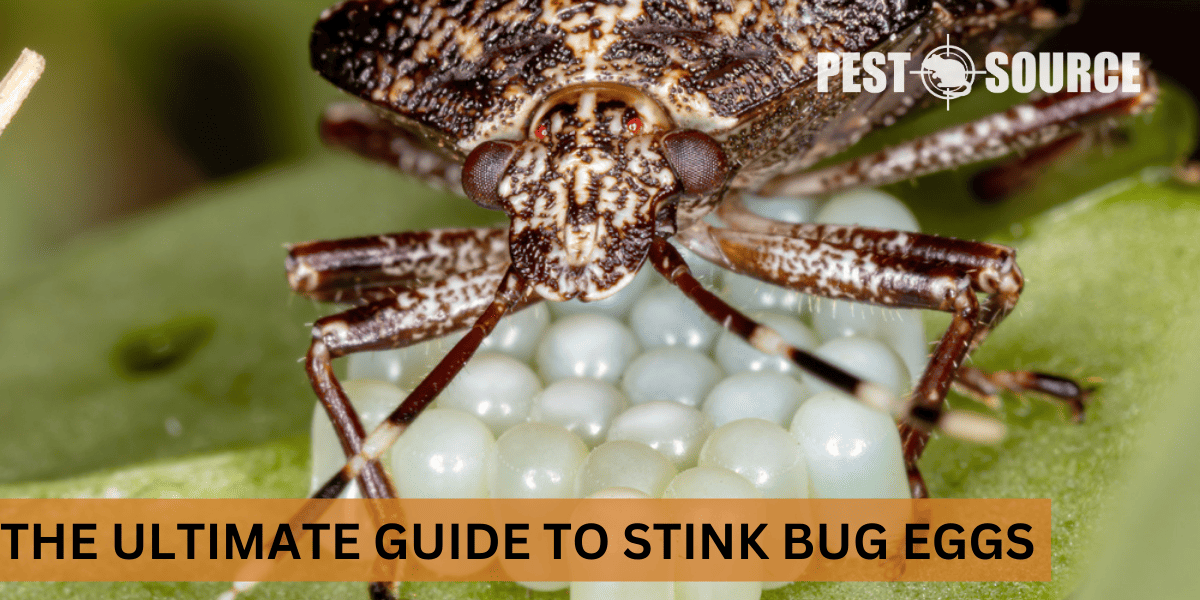There’s hardly anything more frustrating for a homeowner or a gardener than a peaking pest infestation – and stink bugs top the list! These little critters can quickly turn into formidable foes, mostly due to their fast breeding process, which starts with egg-laying. So, if you’re looking to control a budding stink bug invasion, tackling the root of the problem – their eggs – can be your key strategy.
Take a deep dive into our extensive guide, where we tackle everything you need to know about stink bug eggs: how to identify them, tips to prevent their spread, and proven methods to rid your space of them altogether. Let’s reclaim your home and garden from these uninvited guests!
POINTS
- Stink bugs lay eggs in clusters, typically on the undersides of leaves where their offspring will have immediate access to food. These eggs are barrel-shaped with a unique circular cap, and their color can vary based on species and environmental factors.
- Stink bugs undergo incomplete metamorphosis, developing through various nymph stages that increasingly resemble the adult form before fully maturing. Any stink bug egg can potentially lead to 400 more eggs during the insect’s lifetime, allowing for significant population growth within a short period.
- An infestation of these pests can lead to substantial damage, particularly to agricultural crops, as nymphs and adults alike feed on stems, leaves, and fruits.
- Preventing stink bug egg infestations involves regular garden inspections, use of natural pesticides, maintenance of a clean environment to reduce breeding grounds, application of row covers, and practicing companion planting with stink bug-repelling plants.
- In cases where prevention and personal control measures are ineffective, professional pest control services can provide comprehensive treatment plans including more potent pesticides and follow-up treatments to ensure complete stink bug eradication and prevention of future infestations.
What are Stink Bug Eggs and Why are They Important?
What are stink bug eggs?
Stink bug eggs are small, barrel-shaped ovum produced by female stink bugs. Their intricate design makes them unique, as they feature a circular cap on top. These eggs are not just a product of reproduction, but also an invitation to a potential infestation, given the rapid pace at which these insects populate.
When is the mating season of stink bugs?
Stink bug activity dramatically increases during their mating season, which usually falls between May and August. During these warm and humid months, stink bugs are highly visible and active, making it a prime time for them to lay their eggs.
How do stink bugs attract potential mates?
Interestingly, stink bugs attract potential mates using a combination of chemistry and physics. They emit pheromones, special chemical signals, that attract other stink bugs. They also create vibrations by rubbing their legs and wings together. These vibrations also attract the opposite sex, increasing their chances of successful mating.
What factors influence the mating and egg-laying behaviors of stink bugs?
A variety of factors can influence stink bug behavior, notably temperature and daylight. As we’ve noted, they are most active between May and August when the weather conditions are warm and humid. Apart from environmental factors, the availability of food and mating partners also influences their mating and egg-laying behaviors.
Why is it important to understand the mating and egg-laying season of stink bugs?
Understanding the mating and egg-laying patterns of stink bugs is crucial for their successful identification, control, and prevention. When you’re aware of their reproductive calendar, you can precisely time your preventive and management measures, thus increasing their effectiveness.
What Do Stink Bug Eggs Look Like?
What do stink bug eggs look like?

Stink bug eggs are quite distinctive. They are approximately 1mm in diameter, shaped like a tiny barrel with a neat circular cap on the top. The eggs are usually laid in clusters of 20-30 on the underside of leaves, a strategic location that protects the potential offspring from predators and harsh environmental conditions.
What is the size and shape of the stink bug egg?
As previously mentioned, stink bug eggs are about 1mm in diameter. Their unique barrel shape is one key identifier that sets them apart from the eggs of other insects.
How does the color of the egg vary, and what determines this variation?
The color of stink bug eggs varies depending on the species and the temperature at which they are laid. Generally, the eggs are light green or blue, but they can also exhibit a yellow tint or other color variations. As the embryo develops, two red spots may become visible through the egg.

How are stink bug eggs different from other insect eggs you might find?
One of the main differentiating features of stink bug eggs is their barrel-like shape with a circular cap. Other insect eggs might be spherical or oval without a distinct cap. Moreover, stink bugs are known to lay their eggs in neat rows or clusters, which is not common with all insect species.
The scientific insight: How do female stink bugs manipulate the color of their eggs?

An intriguing aspect of stink bug biology is their ability to influence the color of their eggs based on the reflected light from the egg-laying surface. According to the findings published in Current Biology, females can selectively add a dark pigment to the eggs, which is believed to act as a natural sunscreen, protecting the vulnerable DNA of the developing bug.
For instance, in nature, stink bugs lay their eggs on leaves, typically placing darker eggs on top surfaces directly exposed to sunlight, and lighter eggs on the shaded underside of the leaf. The exact pigment used is still unknown but is suspected to be related to melanin – the planet’s most abundant dark pigment.
The Life Cycle of Stink Bugs
Stink bugs lead an interesting life, marked by stages of transformation that are integral to their survival and propagation.
What is the lifecycle of stink bugs?

The lifecycle of stink bugs is started with egg laying by the female stink bugs. Then, the eggs hatch into nymphs, which go through five instar stages before they finally metamorphose into adult stink bug.
How do stink bugs undergo metamorphosis?
Stink bugs undergo incomplete metamorphosis or hemimetabolous metamorphosis. This means that they do not have a pupal stage like insects that undergo complete metamorphosis. Instead, they have series of nymphal stages that increasingly resemble the adult form.
What are the various stages of nymph development?
Upon hatching, stink bug nymphs pass through five growth stages known as instars. With each instar, they shed their skin, grow larger, and appear more like the adult stink bug. Colouration and markings commonly vary among instars and species.
How do nymphs differ in appearance and behavior from adult stink bugs?

Nymphs can be quite distinct in appearance from mature stink bugs. Depending on the species, they range from brightly coloured, often bright yellow, orange, or red shortly after hatching with contrasting patterns, to a more consistent brown, gray, or green. While adult stink bugs have fully developed wings, nymphs only have wing pads, which gradually develop through the instars.
In terms of behavior, nymphs and adults show some differences too. After hatching, nymphs usually stay close together but scatter as they grow. Unlike the adults, they cannot fly but they are capable of causing significant damage to host plants by feeding on them.
What is the duration from laying to hatching of stink bug eggs?
Stink bug eggs hatch within 4-5 days of being laid. Hatching is synchronized, meaning all eggs in a cluster hatch around the same time due to vibrational cues provided by the cracking of the eggs.
How do stink bug eggs hatch?

Stink bug eggs hatch in response to a vibrational cue given by the cracking of the egg’s shell. Fully developed embryos start hatching as soon as they receive this vibration cue, leading to a near simultaneous hatching of the entire cluster.
Reproduction Habits of Female Stink Bugs
An understanding of the impressive reproductive capability of female stink bugs can be daunting but necessary to manage these pests effectively.
When do stink bugs lay eggs?
The exact timing of when stink bugs lay eggs can be variable, largely depending on the species and environmental conditions. Generally, stink bugs lay eggs during the warm months, typically between May to August.
How many eggs do stink bugs lay, and how often?
Female stink bugs lay their eggs in clusters, often in numbers ranging between 20 to 30 eggs at a time. Remarkably, a female stink bug can lay eggs several times a day, with the potential to lay up to 100 eggs in a single day.
How many eggs can a female stink bug lay in her lifetime?
A female stink bug’s reproductive potential is impressive. Throughout her lifespan, a stink bug can lay up to 400 eggs, creating significant concern for homeowners and agriculture where these insects are found.
Do stink bugs exhibit any form of parental care over their eggs?
Some species of stink bugs show off an unexpected maternal side, providing parental care for their eggs. The female may guard her cluster of eggs, aggressively defending them from predators and parasitic wasps that might attempt to lay their eggs within the stink bug eggs.
How many generations of stink bugs can occur in a year?
Typically, stink bugs produce a single generation per year, especially in cooler climates. However, warmer spring and summer conditions can lead to multiple generations – sometimes two or three – within a year. This accelerates their rate of proliferation, leading to larger infestations if not appropriately managed.
Where are Stink Bug Eggs Commonly Found?
Do stink bugs lay eggs inside houses or structures?
While stink bugs can indeed be found indoors, especially during colder months, they usually do not lay eggs inside homes or other human-made structures. They tend to lay eggs in natural outdoor environments where food sources are readily available.
Where do stink bugs lay their eggs?
Stink bugs prefer to lay their eggs on the undersides of leaves on host plants. This strategic choice of egg-laying spot offers some protection from predators and the elements.
Do stink bug eggs lay on windows or walls?
Stink bugs have been known to congregate on the sunny sides of homes and other structures, including windows and walls, especially during the fall season. However, they usually do not lay eggs on these surfaces.
Do stink bugs make nests?
Unlike some other insects, stink bugs do not make nests. Females lay their eggs in rows or clusters on the undersides of leaves, instead of constructing nests for their eggs.
Where do stink bugs nest?
As aforementioned, stink bugs do not actually nest. They live in a variety of natural habitats, including fields, forests, and gardens, but they do not construct a specific nest structure.
What are the common places to find stink bug eggs outdoors?
Stink bug eggs can be found in several outdoor locations. Common places include the undersides of leaves on both ornamental and agricultural plants. Some species of stink bugs prefer certain types of plants over others for laying their eggs.
Are there specific plants or leaves preferred by stink bugs for laying eggs?
Stink bugs do exhibit some selectivity when choosing a location to lay their eggs. Certain species have preferences for specific plants. For example, the brown marmorated stink bug, one of the most common species, is particularly attracted to crops like corn and soybeans, among others. Monitoring your plants regularly, especially those in this category, can help in early detection and prevention of a possible infestation.
Why are Stink Bug Eggs a Concern?
Stink bug eggs might seem insignificant due to their small size, but their impact on agriculture and the potential for home infestation is quite substantial.
How do stink bug eggs affect crops and farming?
Once they hatch, stink bug nymphs are capable of causing significant damage to agricultural crops. They feed on leaves, fruits, and stems, leading to considerable losses. Early detection of egg clusters can be a critical step in controlling the damage caused by these pests.
How do stink bug nymphs impact agricultural crops?
Nymphs, just like their adult counterparts, are significant pests on crops. They damage plants by sucking sap from stems and leaves. This can weaken the plant, disrupt its growth and productivity, and may lead to the plant’s death in severe infestations.
What are the potential threats of a stink bug infestation?
A stink bug infestation can lead to various problems. In homes, the presence of stink bugs can be an annoyance. In large numbers, stink bugs are capable of producing an unpleasant odor when threatened or squished.
On farms and gardens, a stink bug population can devastate crops. Stink bug damage is especially harmful for fruits and vegetables, as their feeding habit leaves scars and depressions on the surface of the crops. This affects both the yield and the quality of crops, causing significant economic losses.
For these reasons, it is essential to take steps to control and prevent stink bug infestations effectively.
How to Identify and Get Rid of Stink Bug Eggs?
Knowing that vigilant prevention and early detection are crucial for stink bug control, let’s look at how to identify and get rid of stink bug eggs.
Do stink bugs lay eggs in the house?
While you may find stink bugs in your home, particularly during the cooler months, they rarely lay eggs indoors. Their eggs are generally laid on outdoor plants where immature stink bugs can have immediate access to food upon hatching.
How can one differentiate stink bug eggs from other insect eggs found in homes?
Due to their unique characteristics, stink bug eggs can be differentiated from other insect eggs. Remember, stink bug eggs are tiny (about 1 mm in diameter), barrel-shaped, and often laid in clusters in neat rows. Look out for these signs when inspecting for eggs.
How to get rid of stink bug eggs?
- Inspect Your Garden Regularly: These critters prefer to lay their eggs on the underside of leaves, so it’s crucial to inspect your garden regularly and remove any eggs found.
- Use Natural Pesticides: Soap-based insecticides and neem oil can be highly effective in dealing with stink bugs. Apply according to the directions on the product’s label.
- Remove Foliage and Weeds: By doing this, you will be removing potential breeding and feeding grounds for stink bugs.
- Employ Row Covers: Use row covers on your garden plants to physically prevent stink bugs from accessing them and laying eggs.
- Attract Natural Predators: You can employ nature’s help in your fight against stink bugs. Here are some options:
- Parasitic Wasps: Wasps like Trissolcus japonicus lay their eggs inside the stink bug eggs, and the wasp larvae feed on the developing stink bug embryos, interrupting their lifecycle.
- Predatory Insects: Insects such as katydids, crickets, ground beetles, earwigs, and jumping spiders prey on stink bug eggs. They either devour the eggs whole or pierce them with their mouthparts and suck out the contents.
- Birds: Some bird species, such as bluebirds, robins, and swallows, may eat stink bug eggs if they find them.
Prevention is Better than Cure: How to Prevent Stink Bugs?
Being proactive in the battle against stink bugs can be significantly more straightforward and less stressful than trying to deal with an active infestation. Here are some steps you can take to prevent stink bugs from taking over your home and garden:
- Seal Off Entry Points: Keep stink bugs out of your home by sealing any potential entry points. Use caulk or a similar substance to seal cracks or gaps in doors, windows, and walls.
- Maintain a Clean Environment: A clutter-free garden reduces hiding and breeding spots for stink bugs. Regularly removing fallen leaves and crops residues can make your yard less appealing to these pests.
- Implement Companion Planting: Some plants repel stink bugs. Growing them in your garden can serve multiple purposes: it can enhance your garden’s beauty and diversity while repelling stink bugs. Some plants that are known to deter stink bugs include marigolds, chrysanthemums, tansy, and radishes.
- Use Stink Bug Traps: Consider investing in commercial stink bug traps. These traps use pheromones to attract and trap the bugs, aiding your efforts to keep your home stink bug-free.
- Use Outdoor Lighting Wisely: Stink bugs, like many insect species, are attracted to light. Use this to your advantage! Changing exterior lighting to less attractive yellow bulbs or sodium vapor lights can help cut down on the number of bugs drawn to your home.
- Store Food in Airtight Containers: Make sure you store your food in airtight containers. Stink bugs, like most pests, are attracted to food and the scent of it. Securing your food can remove this attraction.
By following these preventive measures, you can drastically reduce the chance of a stink bug infestation, protecting your home, garden, and peace of mind.
Seeking Professional Help for Stink Bug Infestations
Despite your best efforts, sometimes stink bug infestations can go beyond your capacity to control. In these situations, it’s crucial to seek professional help.
When and why should you call a pest control professional for stink bugs and their eggs?
If stink bugs have managed to establish a substantial population in your home or garden, or if your DIY control measures don’t seem to be reducing the infestation, it may be time to seek professional help. A pest control expert can thoroughly inspect your property, confirm the type of pest, and provide a comprehensive treatment plan tailored to your specific situation.
How can pest control professionals assist in eliminating stink bugs?
Professional pest control services have the advantage of experience and access to more potent and effective pesticides that are restricted for general use. By conducting a comprehensive home evaluation, these professionals can identify not just evident infestations, but also potential breeding areas and entry points. They can provide a treatment plan that kills the existing stink bugs and their eggs while preventing further infestations.
Moreover, a professional pest control service often offers follow-up inspections and treatments, ensuring post-treatment effectiveness and averting any chance of resurgence.
Conclusion
Understanding and managing stink bug eggs can seem like a challenging task, but armed with knowledge and expert guidance, it becomes manageable. By recognizing stink bug eggs, knowing their lifecycle, and adopting solid preventive measures, you can protect your home and garden from these pesky invaders. However, remember, should the issue escalate beyond your control, professional pest management services are always there to assist you in eliminating stink bugs completely. Your home is your sanctuary, and it’s essential to keep it stink bug-free!



